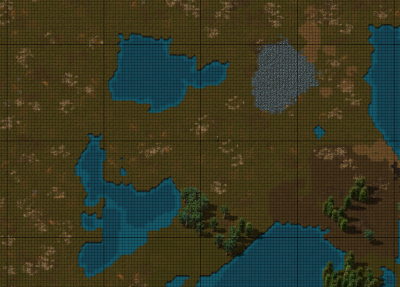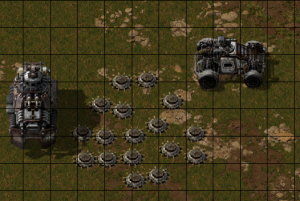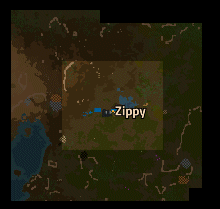Map structure: Difference between revisions
GreyTheWolf (talk | contribs) →Real world size analogy: Developed an experiment to prove that 1 tile = 1 meter, posted results. |
m →Tile: Link to tile page. |
||
| (11 intermediate revisions by 6 users not shown) | |||
| Line 3: | Line 3: | ||
== Tile == | == Tile == | ||
''This section is about the area and distance unit. For placeable tiles, see [[tile]].'' | |||
[[File:MapStructure-GridExample.png|thumb|right|400px|The tile grid shown in-game; chunks (32×32 tiles) are indicated by the thicker black lines. Click to see at higher resolution.]] | [[File:MapStructure-GridExample.png|thumb|right|400px|The tile grid shown in-game; chunks (32×32 tiles) are indicated by the thicker black lines. Click to see at higher resolution.]] | ||
| Line 17: | Line 19: | ||
=== Example distances === | === Example distances === | ||
* Area covered by [[Radar]]: about | * Area covered by [[Radar]]: about 200 tiles diameter (100 tiles in each direction, bounded to the matching [[#Chunk|chunk]]). | ||
* It takes about 1 minutes and 52 seconds for a player to run 1000 tiles without being given a speed boost (such as via an [[exoskeleton]]). | * It takes about 1 minutes and 52 seconds for a player to run 1000 tiles without being given a speed boost (such as via an [[exoskeleton]]). | ||
| Line 27: | Line 29: | ||
== Chunk == | == Chunk == | ||
[[File:radar_revealing_sectors.gif|thumb|220px|Animation of radars revealing chunks.]] | |||
The map is divided into a grid of '''chunks''', each 32x32 tiles (1024 tiles total). | |||
* | |||
Several mechanics work on a chunk-by-chunk basis: | |||
* | * The map is generated chunk-by-chunk during play. 20 chunks distance in each direction around each player is slowly generated over time, or immediately if revealed directly and not yet generated. | ||
* [[Enemies#Expansions|Enemy expansion]] is | * [[Player|Players]], [[Radar|radars]], [[Roboport|roboports]], [[Spidertron|spidertrons]], and fired [[Artillery|artillery shells]] reveal chunks and provide [[Radar#Coverage|live coverage]] in remote view on a chunk basis. | ||
* [[Pollution]] and [[Spores|spores]]{{SA}} are calculated and spread on a chunk basis. (This can generate chunks without revealing them.) | |||
* [[Enemies#Expansions|Enemy expansion]] is calculated on a chunk basis. | |||
* [[Demolisher]]{{SA}} territories are chunk-aligned. | |||
* Enemy pathfinding works in multiple stages, and the first stage is chunk-based. [https://factorio.com/blog/post/fff-317] An unintended result is enemies tend to walk along chunk borders. Also biters and spitters will sometimes attack obstacles at chunk borders that they would normally navigate around. | |||
* To reduce computation, entire chunks are set inactive when nothing important is happening in them. E.g.: Chunks with only fish or idling enemies may be set inactive, halting their idle movement. | |||
== Visualizing tiles and chunks in-game == | == Visualizing tiles and chunks in-game == | ||
| Line 39: | Line 46: | ||
A tile grid overlay is available which shows the grid upon which the map is built: | A tile grid overlay is available which shows the grid upon which the map is built: | ||
* The grid can be shown whenever the player pauses the game (by default with {{Keybinding| | * The grid can be shown whenever the player pauses the game (by default with {{Keybinding|shift|space}}). | ||
** This is configured under Settings->Interface->'''Show grid when game is paused'''. | ** This is configured under Settings->Interface->'''Show grid when game is paused'''. | ||
* To see the grid while the game is still running, [[Debug mode|debug settings]] can be used: | * To see the grid while the game is still running, [[Debug mode|debug settings]] can be used: | ||
| Line 45: | Line 52: | ||
** Ticking '''show-tile-grid''' under '''always''' will show the grid at all times; ticking it under '''debug''' will show it only when debug mode is activated. | ** Ticking '''show-tile-grid''' under '''always''' will show the grid at all times; ticking it under '''debug''' will show it only when debug mode is activated. | ||
** If '''debug''' is chosen the grid will become visible whenever {{Keybinding|F5}} is used to enable debug display. Configuring debug mode in this way allows {{Keybinding|F5}} to be used as a convenient toggle for turning the grid on and off, which can be useful when attempting to place entities according to a neat and/or symmetrical design. | ** If '''debug''' is chosen the grid will become visible whenever {{Keybinding|F5}} is used to enable debug display. Configuring debug mode in this way allows {{Keybinding|F5}} to be used as a convenient toggle for turning the grid on and off, which can be useful when attempting to place entities according to a neat and/or symmetrical design. | ||
{{C|Main}} | |||
Latest revision as of 02:44, 17 November 2025
Map structure describes the division of the game world into standard units: tiles and chunks. Tiles are the building blocks of the game, upon which all distance and area measurements are based. Chunks are blocks of 32×32 tiles used for various area-based calculations.
Tile
This section is about the area and distance unit. For placeable tiles, see tile.

A tile is a square which defines the smallest possible piece of the game world; the map is built on a grid of tiles. The tile is the basis for all area and distance measurement. Entity sizes are defined in terms of tiles; for example the rocket silo - the largest entity in the game - is 9 tiles wide and 9 tiles high, usually referred to as 9×9. The smallest possible entity size is therefore one tile, 1×1. Examples of 1×1 entities include transport belts and chests.
The maximum size of the map is a square 2 million tiles on each side, a total of 4 trillion tiles. In practice the map in an average game is likely to be in the range of hundreds of thousands of tiles up to a few million at most.
Tile grid alignment
Almost all placeable entities are aligned to the tile grid when placed in the game. Exceptions include the land mine and vehicles such as the car, tank, locomotive and wagons. Non-placeable entities that do not align to the grid include enemies, trees and decoratives.

Example distances
- Area covered by Radar: about 200 tiles diameter (100 tiles in each direction, bounded to the matching chunk).
- It takes about 1 minutes and 52 seconds for a player to run 1000 tiles without being given a speed boost (such as via an exoskeleton).
Real world size analogy
One tile is generally assumed to be one square meter in size. This measurement is proven to be technically true, and can be verified in-game. A test conducted via car will reveal that covering 250 tiles at 208.0 km/h (57.777 m/s) will take 260 game ticks (4.333 s). Using this data, it can be proven that 57.777 m/s ÷ (250 tiles / 4.333 s) ≈ 1 m/tile.
Chunk

The map is divided into a grid of chunks, each 32x32 tiles (1024 tiles total).
Several mechanics work on a chunk-by-chunk basis:
- The map is generated chunk-by-chunk during play. 20 chunks distance in each direction around each player is slowly generated over time, or immediately if revealed directly and not yet generated.
- Players, radars, roboports, spidertrons, and fired artillery shells reveal chunks and provide live coverage in remote view on a chunk basis.
- Pollution and spores
 are calculated and spread on a chunk basis. (This can generate chunks without revealing them.)
are calculated and spread on a chunk basis. (This can generate chunks without revealing them.) - Enemy expansion is calculated on a chunk basis.
- Demolisher
 territories are chunk-aligned.
territories are chunk-aligned. - Enemy pathfinding works in multiple stages, and the first stage is chunk-based. [1] An unintended result is enemies tend to walk along chunk borders. Also biters and spitters will sometimes attack obstacles at chunk borders that they would normally navigate around.
- To reduce computation, entire chunks are set inactive when nothing important is happening in them. E.g.: Chunks with only fish or idling enemies may be set inactive, halting their idle movement.
Visualizing tiles and chunks in-game
A tile grid overlay is available which shows the grid upon which the map is built:
- The grid can be shown whenever the player pauses the game (by default with SHIFT + SPACE).
- This is configured under Settings->Interface->Show grid when game is paused.
- To see the grid while the game is still running, debug settings can be used:
- Pressing F4 will show the Debug settings window.
- Ticking show-tile-grid under always will show the grid at all times; ticking it under debug will show it only when debug mode is activated.
- If debug is chosen the grid will become visible whenever F5 is used to enable debug display. Configuring debug mode in this way allows F5 to be used as a convenient toggle for turning the grid on and off, which can be useful when attempting to place entities according to a neat and/or symmetrical design.